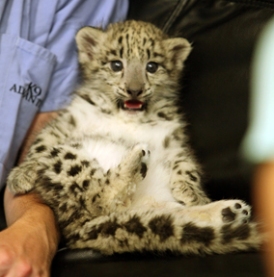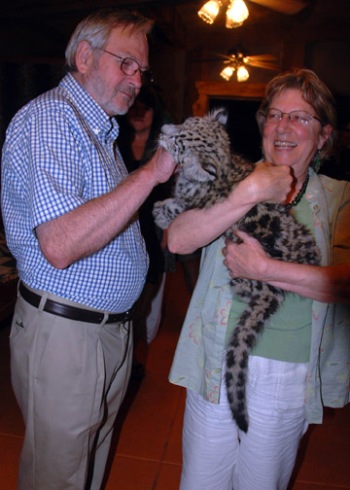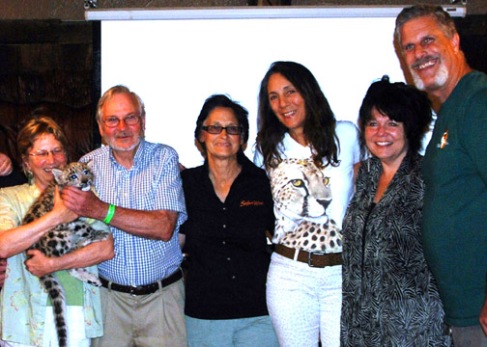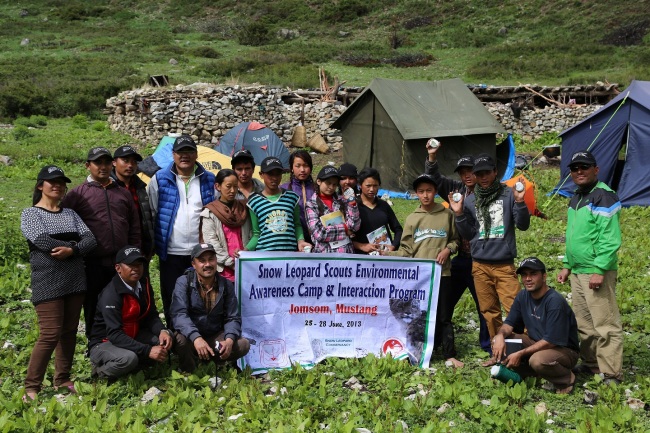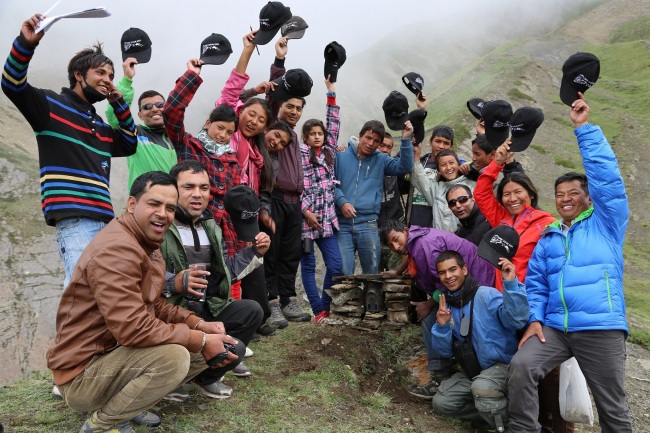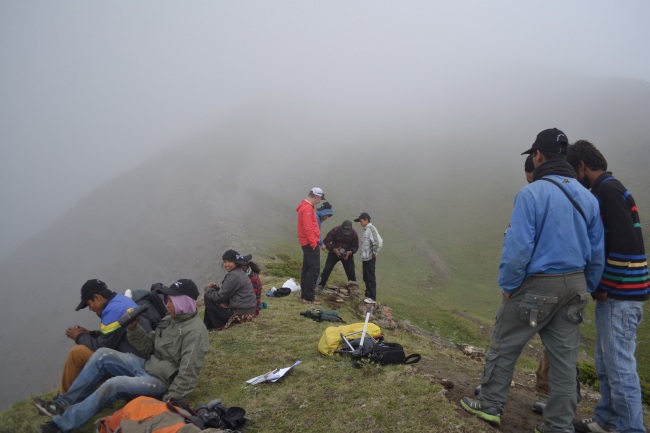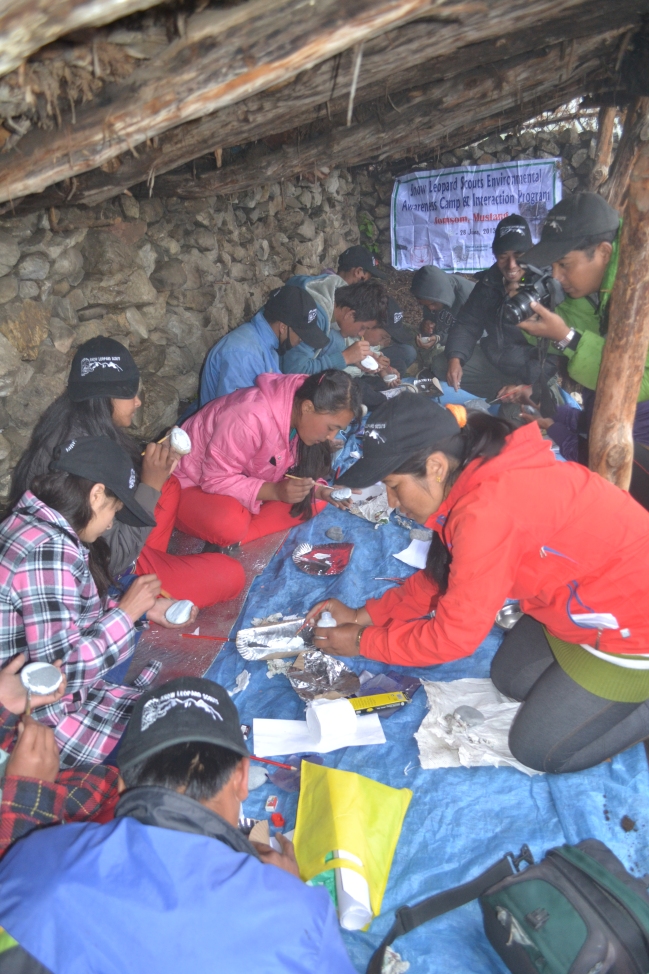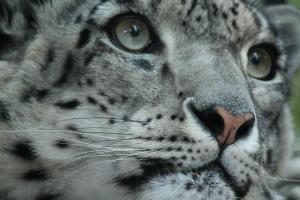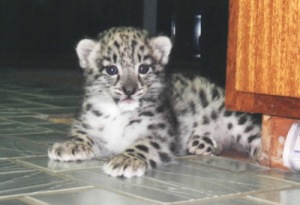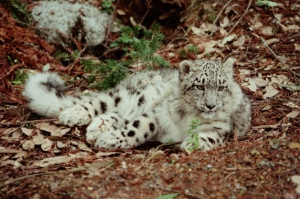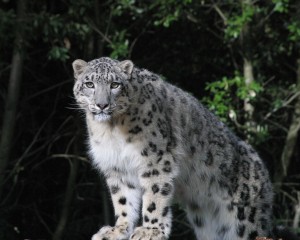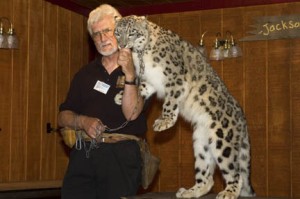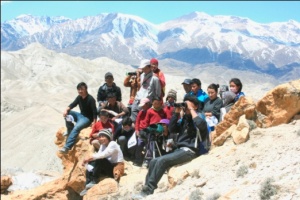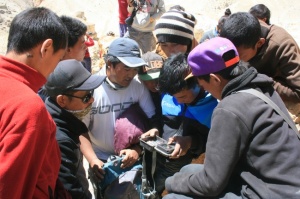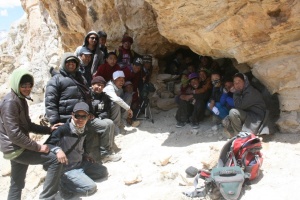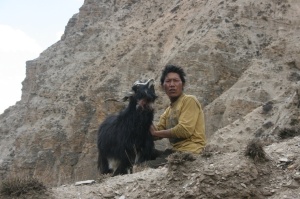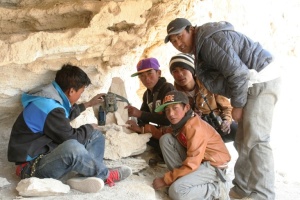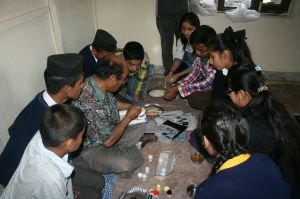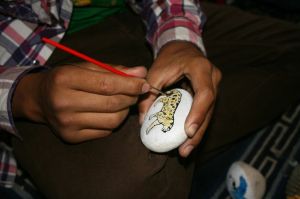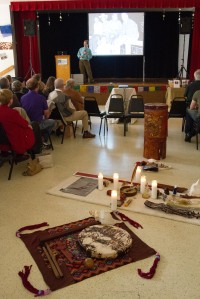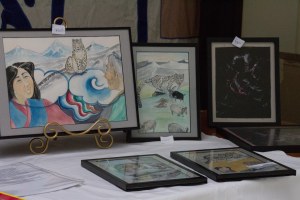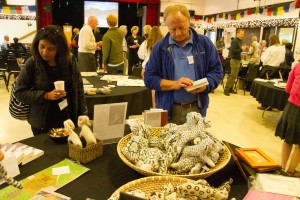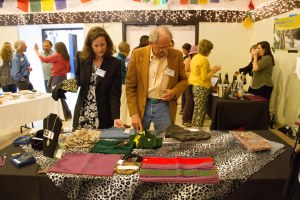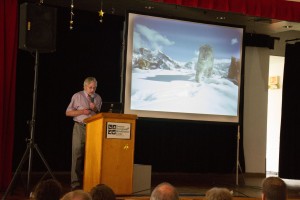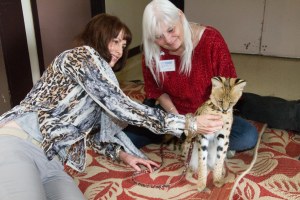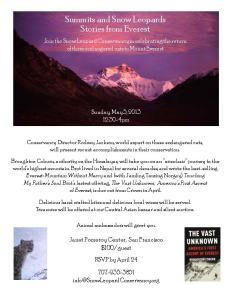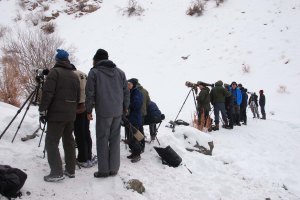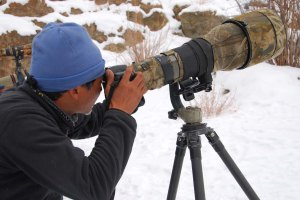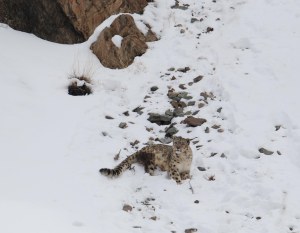Our Blog Has Moved!
The Snow Leopard Conservancy blog has moved to our website. Please visit to www.snowleopardconservancy.org/blog to stay current with our updates and view our blog history!
Meet Baby “Jackson”!
Snow Leopard Conservancy is very proud to introduce Project Survival’s Cat Haven’s 8 week old snow leopard cub, “Jackson”! Dale Anderson, founder of Project Survival’s Cat Haven, and president Wendy Debbas, chose the name “Jackson” for this adorable cub in honor of Dr. Rodney Jackson.
Project Survival Cat Haven promotes the conservation and preservation of wild cats in their native habitat by educating visitors and publicizing the work done by Project Survival Cat Conservation Group. Project Survival is engaged in fundraising, including the creation of endowments, to support wild life specialists and educators working in range countries. Over the years they have been wonderful friends and supporters of Snow Leopard Conservancy, raising funds and awareness for these amazing cats.
When Dr. Jackson recevied the phone call from Dale announcing the arrival and naming of “Jackson”, he was a bit at a loss for words. The following day in an email to Project Survival, Rodney wrote: “A day later I remain stunned by yesterday’s phone call from Dale. Wow, what a honor to have a real, live snow leopard named after me. As I mumbled to Dale, a 4-legged furry creature is a great “son” to have!”
On Sunday July 28, “Jackson” made his debut during a presention by Rodney Jackson at Safari West. Overnight guests at the wildlife park near Santa Rosa, California were treated to an educational talk about snow leopards in the wild by Dr. Jackson and an introduction of baby “Jackson” by Dale Anderson and Wendy Debbas.
Snow Leopard Scouts Environmental Awareness Camp
Snow Leopard Scouts in Jomsom- Lower Mustang, Nepal attended an Environmental Awareneses Camp. During this camp students were educated and trained in a number of fronts related to snow leopard biology, environmental awareness, nature hiking and wildlife observation, prey ecology, and issues related to people-wildlife conflicts. The participants camped for three full nights, and two full-day field excursions, in the high alpine pasture (Vaprasa-Namu), were made. Students observed various wildlife including red fox (the intermediate predator), pika and other rodents, and blue sheep. The program was coordinated by ACAP rangers, conservation education assistant, conservation education teacher, and SLC coordinators. Among others, the following activities took place–
1. Camera traps: Learning about remote cameras and installing and monitoring them on strategic locations (snow leopard trails) were made. Note Snow Leopard Scouts and local herders have been monitoring snow leopards through remote cameras (in three locations) since 2011. In 2011, the cameras captured three, and in 2012 all three were recaptured along with a cub. This indicated the snow leopard population in Mustang is thriving. On 15 May 2013, the camera located in Muktinath captured a new adult individual! 2012/2013 Snow Leopard Scouts have christened the three snow leopards as Mukti, Nilgiri and Tilicho. The new snow leopard scouts will have opportunity to name the fourth individual.
2. Snow leopard sign-tracking, and blue sheep observation and classification
3. Site characterization along one of the “sing transects” (there are four such transects): Students were also taught about climate change issues and how one may be able to keep track of climate change on snow leopard habitat.
4. Environmental debate: Students were grouped into two and they were given relevant materials on snow leopard and other local wildlife species to go through prior to the debate. The discussion and debate took two hours. The aim was to assess their interests and enthusiasm on snow leopard and other local flora and fauna.
5. Nature drawing (stone and sketch paintings) and field-diary writing.
-text and images by Som Ale
Happy Birthday, Ashakiran!
Today we celebrate the 12th birthday of Ashakiran, a snow leopard very dear to our hearts. Asha is a retired ambassador snow leopard with the Wild Cat Education and Conservation Fund in Occidental, California. During the past 12 years Asha has helped raise over $100,000 in donations for Snow Leopard Conservancy!
We are posting these beautiful pictures Ashakiran to wish her a very Happy Birthday and thank her and WCECF for all they’ve done to raise awareness for the snow leopard and their support of SLC.
Camera Trapping in Nepal
Update from Nepal: Snow Leopards Scouts–Camera Trapping
Fifteen students, four teachers, one herder and three Annapurna Conservation Area Project (ACAP) staff joined two SLC coordinators on a one-day field excursion to Sakawo, a snow leopard hotspot in high alpine pasture with abundant snow leopard signs. Here they learned to observe and classify blue sheep as well as identify and characterize snow leopard signs and habitat. Training was also given on remote camera installation and monitoring. The excursion concluded with environmental games, debates, and information exchange with Conservation Area Management Committee members.
In Upper Mustang snow leopard habitat Bikram Shrestha and Pema Tshering coordinated local herders and students to install five camera traps at sites in different sites in Samdzong, Sakawo (Lomanthang) and Marang. In 2012, one female snow leopard with two cubs were captured in Sawawo, while the camera in Samdzong also captured one image (although barely clear). It was interesting to note the interest and enthusiasm among students to monitor the female with cubs in Sakawo. SLC-Nepal program will help students achieve the snow leopard monitoring for years.
Arts Competition in Nepal
Field Update from Nepal: Snow Leopard Scouts Committee Stone Painting and Arts Competition
On 20 April, senior artist, Chhewang Jigmi Lowa – resident of Lomanthang, showed students of the Snow Leopard Scouts Committee how to paint wildlife species on small rocks and stones gathered from local streams. Special care was made to select stones or rocks of appropriate shape, structure, and size that resemble regular paperweights used in offices with the side-objective to explore the possibility that the painted stones could replace paperweights in local offices. The artist also trained students for regular sketch arts. Students, after the training and exposure, were assigned to paint high altitude wildlife species on stones. They took part in inter-school arts competition on the theme “Manab- banyajantu bich ko danda newnikaran ko lagi sahakarya garaun (that is, “Joining hands together to mitigate human-wildlife conflicts)”. This theme has been the slogan of the National Wildlife Week (First week, 1-7, of the New Year 2070, Nepali calendar).
Twelve students participated on stone painting activity. They produced 17 different wildlife species on stones. For encouragement, the youth were given small monetary awards. Sonam Dawa (Lama), Dawa Tshering and Sangbo Gurung received the first, second and third prize respectively, and the rest received the consolation prize. In case of sketch paper painting, 11 students participated. Sonam Dawa (Lama), Tamding Dorje, and Pema Wangchen were awarded with the first, second and third prize, respectively, whereas three students obtained consolation prize. Students wrote travel dairies on their “once-in-a-life-time” experience and feelings. These writings and contributions are currently being documented and will ultimately find their ways to one of the snow leopard scouts booklets series, for other fellow students, their parents and other peers to learn, judge, and replicate the actions.
Snow leopard voted #8 for World’s Favourite Species!
Being voted #8 in a contest to find the World’s Favourite Species is nothing to swat a paw at! ARKive, a project of the charity, Wildscreen, uses the power of wildlife imagery to encourage the protection of the natural world. To celebrate their 10th birthday they recently ran a campgain on their website in which thousands of people from over 162 countries voted on their favorite species. While the results show the snow leopard at #8, we here at SLC still think the snow leopard is #1! Check out their full top 10 list and see who you would have voted for.
Summits and Snow Leopards fundraiser was a success!
This year’s SLC biennial fundraiser was fantastic! Thanks to our friends, supporters and amazing volunteers, we not only had a fun and exciting day, but we were able to raise funds to protect the endangered snow leopard. Summits and Snowleopards took place at the Janet Pomeroy Center in San Francisco on May 5 and hosted guest speaker, Broughton Coburn, author of The Vast Unknown–America’s First Ascent of Everest.
Opening ceremonies included a beautiful shamanic blessing complete with an altar, drumming, and conch shell blowing by cultural practitioner, Ernesto Olmos. Following this, guests were able to browse and purchase a variety of treasures and artwork at the Central Asian bazaar and silent auction while enjoying a tempting selection of hand crafted bites and the divine Long Tail Wine from Goosecross Cellars.
Guests enjoyed a very interesting, informative presentation by SLC Director Rodney Jackson of the recent accomplishments of the Snow Leopard Conservancy. Almost as captivating as Rodney’s presentation were ambassador animals Keesa the therapy camel, Kiara the serval, and an adorable fennec fox that guests were able to closely interact with.
Snow Leopard Conservancy invites all of you to attend the next fundraiser in 2015. We’re looking forward to making that one even more fun!
Join us for our Amazing Snow Leopard Fundraiser!
Record breaking snow leopard sightings in Ladakh!
The snows have been good this year, keeping snow leopards to the lower elevations, and closer to tourist camps in the Husing Valley of Hemis National Park. Hemis is truly the Snow Leopard Capital of the World, thanks to protection by the J&K Wildlife Department and local villagers who now perceive the cat as an asset instead of a pest to be eliminated.
It had been over three years since I visited Hemis with one of our special Winter Quests for the Snow Leopard, which we have been offering since 2005, in partnership with KarmaQuest Ecotourism & Adventure Travel. This winter we have two groups, and I joined the first near the end of their stay in the Husing Canyon tented camp along the main trail leading to the small hamlet of Rumbak. This community is the protector of one of the world’s rarest cats.
Under the diligent guidance of SLC-India Trust’s Jigmet Dadul—whom many consider to be the world’s best leopard spotter—Brian and his wife Pam, Karen, Katrina, Gaye and David had the amazing run of six snow leopard sightings in four days! On Day One, they watched a female and two nearly full-grown cubs crossing a high ridge, and an adult male, possibly the dominant cat of the area, resting on a rocky outcrop. The next day they saw a snow leopard moving upslope above the Husing poplar tree plantation, and the following morning they saw another cat on the slopes immediately above camp. Wow! In the 1980s, when Darla and I started our work on snow leopards, this would represent 3-4 years worth of sightings.
I was also in luck. Within 15 minutes of arriving at camp around noon on February 14th (Valentine’s Day, and peak mating season for the cats) my eyes were glued to a spotting scope taking in a minutely detailed male snow leopard happily asleep on a sunny knoll high above the “camp,” and watched by about 25 excited tourists. Actually, there were three separate trekking groups, ours, another comprised of 6 or 7 members and one of 17. The latter were professional photographers from South Africa (with massive 700m + camera lenses), and travel agents from around the world. Fortunately two park wildlife rangers were there to ensure that no one got too close to the cats. Though the people were a good 250-350 meters away on a nearby ridge, the mass of human eyes hovering over tall tripods and long lenses surely presented a somewhat intimidating image to the cat. In typical cat fashion, he would periodically flick his tail several times, only to fall over and sleep for 10-15 minutes—before some movement from the tourists caught his attention, and he would abruptly sit up and stare intently.
Meanwhile, Jigmet and our group were watching a female on a blue sheep kill stretched out on a scree slope in the cold confines of the Husing Gorge. Here, the sun barely penetrates during winter, and it feels as icy and cold as a walk-in freezer. If someone moved abruptly or approached closer than about 130 meters, she would walk upslope to a rocky cliff and sit quietly, all the time carefully watching her kill. After Jigmet moved the group back from that margin of her comfort zone, she immediately relaxed. However, her patience was taxed by the two magpies in attendance, constantly alighting on the kill to sneak some meat. Then she either walked or ran back to lie next to or indeed right over the 2-day old carcass; “Its mine, stay away!“
We returned the following morning, not really expecting her to still be there. But she was! And we enjoyed the privilege of spending 6-8 hours quietly observing her alternatively feeding, resting or chasing those pesky magpies. Clearly, this cat was not about to share her hard-fought meal with any bird, yet she was prepared to tolerate 20 humans watching her every move. I could not but marvel at her tolerance of the over-abundance of two-footed critters. Perhaps this is because so few snow leopard hunts actually end in success.
Enjoying the hospitality of a homestay at one of the Rumbak family’s a few days later, I thought back on the 5-8 years it had taken the Snow Leopard Conservancy – India Trust, SLC-USA, and the wildlife department to favorably turn local attitudes toward this elusive predator. Now these villagers are earning far more income from tourism-related activities than from herding sheep or goats, which all too often end up in the cat’s belly. Many households have abandoned keeping small livestock, thereby lessening the pressure on the sparse and fragile vegetative cover, and leaving more forage for blue sheep, the snow leopard’s natural prey. Using the new found cash to send their kids to good schools, they no longer feel the need to throw stones at or otherwise harass snow leopards—who in turn have become remarkably habituated to human presence.
Not so long ago, it would have been a dream to see just one snow leopard during a 10-day winter snow camp, but last year our group had four sightings, and this group ended up with seven. This is a testament to conservation action, but there are simply no words to express my sense of awe and privilege when this Asian mountain ghost comes into the presence of humans and allows us to marvel at her sheer beauty and superb adaptation for living in this steep, cold mountain desert.
-Rodney
